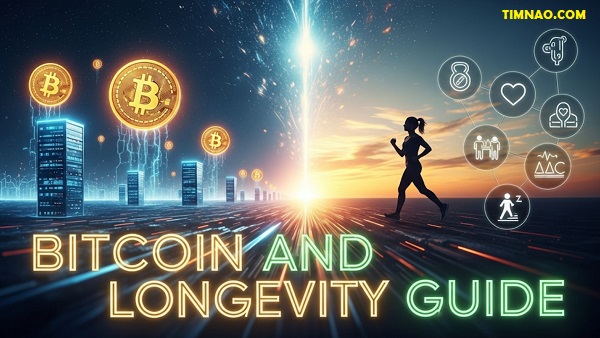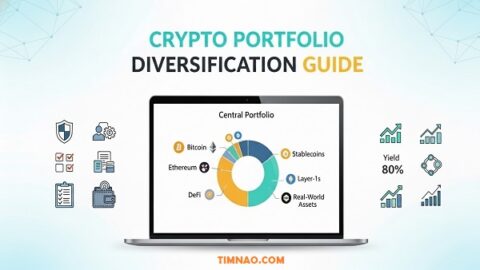Unlocking Freedom with Bitcoin and Longevity: A Life-Changing Guide 🚀
Bitcoin and longevity may sound like two very different worlds, but when you look closer, they share a common thread: both are about preserving what matters most—your time. Bitcoin protects the value of your money against inflation, while longevity strategies safeguard your health so you can fully enjoy the years ahead.
For beginners, this combination isn’t about chasing hype or extreme lifestyles. It’s about learning how small, consistent choices in both finance and health can add up to life-changing freedom. Imagine stacking a little bitcoin each week while also stacking healthy habits like better sleep, smarter nutrition, and daily movement. Over time, both compound to give you more options, more independence, and more years of vibrant living.
In this guide, we’ll break down these powerful ideas into simple, actionable steps. Whether you’re just hearing about Bitcoin for the first time or looking for easy ways to improve your health, you’ll find strategies here that are practical, beginner-friendly, and proven to work.
Table of Contents
- 🌍 Escaping Broken Systems: Why Beginners Must Question Everything
- ⚡ Proof of Work: How Effort Shapes Both Money and Health
- ⏳ Mastering Low Time Preference: Delayed Gratification as a Superpower
- 💰 Bitcoin Basics for Beginners: Why “Hard Money” Matters
- 🧠 Longevity Mindset: Health as Your Greatest Investment
- 🏋️ Practical Protocols: Habits That Extend Both Wealth and Life
- 🌱 Global Examples: Bitcoin Innovation in Energy, Communities, and Health
- 🔑 Taking Self-Custody: Tools Every Beginner Should Start Using
- 🚀 Building Your Future: A Beginner-Friendly Action Plan
🌍 Escaping Broken Systems: Why Beginners Must Question Everything
Most of us grow up believing the systems around us are built to protect us. We’re told that schools prepare us for life, that doctors keep us healthy, and that banks safeguard our money. But if you look closely, you’ll see these systems are often designed for something else entirely: maintaining control, keeping us dependent, and ensuring we never question the rules of the game.
Let’s take money as the first example. For decades, the advice has been simple: work hard, save cash in the bank, and one day you’ll retire comfortably. But here’s the hidden trap—your savings lose value every year because of inflation. Since 1971, when the U.S. dollar was completely detached from gold, purchasing power has steadily eroded. That $100 you saved ten years ago buys far less today. In fact, if you’ve noticed your grocery bill doubling or rent skyrocketing while your paycheck stays flat, you’ve already felt this invisible tax.
Healthcare works the same way. Instead of focusing on prevention, most medical systems wait until people are sick. A doctor is far more likely to prescribe pills than to spend an hour helping you design a sustainable nutrition or exercise plan. Why? Because sickness is profitable, while prevention is not. Pharmaceutical companies make billions from treating symptoms, not curing root causes.
Education isn’t much different. Many schools still prioritize memorization over critical thinking. Students are trained to follow rules, sit still for long hours, and prepare for standardized tests. They’re rarely taught financial literacy, entrepreneurship, or even how to make independent health decisions. The result? Adults who know how to follow directions but struggle to build sovereignty over their own lives.
Here’s the uncomfortable truth beginners need to hear: these systems aren’t broken by accident. They’re designed to keep you in a cycle of dependency. Banks profit when you borrow. Hospitals profit when you’re sick. Big companies profit when you overspend and stay exhausted. That’s why questioning everything is the first step toward real freedom.
But questioning doesn’t mean rejecting everything outright. It means developing the habit of curiosity:
- When your bank offers you a credit card, ask: Who benefits more, me or them?
- When your doctor prescribes medication, ask: What lifestyle change could address this instead?
- When you’re told to save in cash, ask: What happens if inflation outpaces my interest rate?
This mindset shift is powerful. It turns you from a passive consumer into an active decision-maker. And once you start looking deeper, you’ll realize that alternatives exist—whether it’s saving in Bitcoin instead of fiat currency, cooking whole foods instead of relying on packaged meals, or investing in continuous learning outside of formal education.
The biggest risk is not making mistakes. The biggest risk is blindly following systems that quietly drain your time, money, and health. By questioning everything, you open the door to something better: sovereignty.
⚡ Proof of Work: How Effort Shapes Both Money and Health
Once you recognize that systems often work against you, the next question is: What do I do about it? The answer lies in a principle borrowed from Bitcoin itself—Proof of Work.
In Bitcoin, miners run powerful computers that perform countless calculations to secure the network. They can’t fake it; they must put in real energy and time to earn rewards. That’s why Bitcoin is called “hard money.” Every coin represents undeniable effort.
Life works the same way. You can’t shortcut effort. No one else can exercise for you, eat healthy for you, or save money for you. The results you get—whether it’s a stronger body, a healthier bank account, or a clearer mind—are the proof of the work you’ve done.
Think about building muscle. If you lift weights consistently, your body responds. If you skip the gym and expect results, nothing changes. The same is true with savings. If you regularly set aside even $10 in Bitcoin each week, your financial resilience grows. If you spend it all on short-term pleasures, the future remains fragile.
Proof of Work also shows up in skills. Let’s say you want to start a side hustle in graphic design. You don’t instantly become skilled by downloading Photoshop. You get better by designing one project at a time, making mistakes, asking for feedback, and improving slowly. Each project is your proof of work, and over time, that proof compounds into expertise others will pay for.
This principle matters because we live in a culture obsessed with shortcuts. We want instant weight loss, instant wealth, instant happiness. Ads bombard us with “lose 10 pounds in 7 days” or “get rich quick with zero effort.” But shortcuts rarely last. True resilience—whether in money or health—is built through consistent effort.
Here’s how beginners can apply Proof of Work in daily life:
1. Financial Proof of Work
- Automate small Bitcoin savings every week. Apps like Cash App or Strike make this simple.
- Learn the basics of self-custody using beginner wallets like BlueWallet. Each step builds confidence.
- Track your expenses for one month. Awareness is the first proof of work in money management.
2. Health Proof of Work
- Walk 20–30 minutes daily. Movement is the most underrated health investment.
- Prioritize sleep by setting a fixed bedtime. Rest is where your body processes the “work” you’ve done.
- Swap one processed meal each day with a whole-food alternative. Start small and let consistency build.
3. Learning Proof of Work
- Dedicate 20 minutes a day to reading about finance, health, or skill development. Knowledge compounds just like money.
- Use free resources: YouTube tutorials, podcasts, and open courses are everywhere.
- Document your progress—writing notes or tracking metrics is your proof that learning is happening.
Notice how these steps don’t require extreme resources. They require commitment. Proof of Work is about showing up, again and again, until results accumulate.
One inspiring real-world example comes from Bitcoin miners in cold countries. They discovered that the heat generated from mining equipment can be reused to warm homes, dry wood, or even make hot tubs. What looked like wasted energy became valuable because they put in the effort to think differently. That same mindset applies to your personal life. What looks like a waste of time today—say, practicing guitar for 30 minutes—can become incredibly valuable in the future when your skill opens doors to teaching or performing.
The more you adopt Proof of Work as a personal philosophy, the less you’ll be tempted by shortcuts. You’ll start seeing effort not as a burden, but as the price of freedom. Bitcoin miners secure the network by proving their work. You secure your future by proving yours—day by day, decision by decision.
👉 Next, we’ll explore how low time preference—the discipline of delaying gratification—becomes the superpower that connects both Bitcoin savings and healthy living.
⏳ Mastering Low Time Preference: Delayed Gratification as a Superpower
If Proof of Work is about showing up and putting in effort, low time preference is about thinking ahead and valuing the long-term over short-term pleasure. In simple terms, it’s the ability to delay gratification today for bigger rewards tomorrow.
This mindset is the opposite of how most modern systems encourage us to live. Ads tempt us with “buy now, pay later.” Social media rewards us with instant likes instead of meaningful progress. Fast food is always easier than home cooking. But when you choose the easy, short-term option over and over, you trade away your future for temporary comfort.
Take money as an example. Suppose you earn $50 today. You could buy a new gadget, or you could save it in Bitcoin. The gadget will probably be outdated in a year, while that Bitcoin—if history continues its trend—may be worth significantly more down the line. By practicing low time preference, you sacrifice a quick dopamine hit now for long-term financial freedom later.
The same principle applies to health. Choosing to eat a salad instead of pizza, or going for a run instead of binge-watching shows, may feel like a sacrifice today. But over months and years, those “sacrifices” add up to more energy, fewer doctor visits, and potentially decades of healthy living.
For beginners, mastering low time preference doesn’t require extreme self-denial. It’s about training your brain to consider your future self in every decision. Here are some beginner-friendly ways to start practicing:
- Use the 10-Year Question: Before spending money or making a big lifestyle choice, ask: Will I thank myself for this decision in 10 years? This simple pause often shifts your perspective.
- Start with Small Delays: Instead of buying that new gadget instantly, wait 30 days. If you still want it after a month, it’s probably worth it. If not, you’ve saved money and avoided impulse regret.
- Automate Good Choices: Set up automatic Bitcoin savings or meal-prep on Sundays. When good decisions are automated, your future self reaps the rewards without daily battles.
- Visualize Compound Benefits: Remind yourself that consistent habits—whether saving $10 a week or jogging 3 times a week—don’t look impressive in the short run but become life-changing over decades.
A powerful real-world analogy comes from investing. Warren Buffett, one of the richest people in the world, attributes much of his wealth not to genius stock picks but to time in the market. He started investing early and allowed compounding to work its magic for decades. That’s low time preference in action.
Low time preference is also central to Bitcoin itself. By design, Bitcoin rewards those who hold it long-term instead of trading it constantly. Investors who patiently held their coins through multiple “bear markets” ended up with life-changing wealth. Those who sold at the first dip often regretted their impatience.
The big takeaway for beginners: start training your low time preference muscle today. The more you practice delaying gratification, the more resilient you’ll become against marketing tricks, unhealthy habits, and short-term panic. Over time, this mindset becomes a superpower that protects both your wealth and your health.
💰 Bitcoin Basics for Beginners: Why “Hard Money” Matters
Now that you understand the philosophy behind low time preference, let’s get practical about Bitcoin itself. To many beginners, Bitcoin sounds like just another investment trend. But at its core, Bitcoin is something far more fundamental: hard money.
What Does “Hard Money” Mean?
Hard money refers to money that cannot be easily manipulated, printed, or inflated away. For centuries, gold served this role because it was scarce and required real effort to mine. Governments could not simply create more of it on a whim.
Bitcoin is digital hard money. It’s scarce (only 21 million will ever exist), decentralized (no central authority controls it), and secure (backed by the most powerful computer network in the world).
Contrast this with “soft money” like the U.S. dollar or the euro. Central banks can print trillions at the click of a button. Every time they do, the purchasing power of your savings shrinks. That’s why groceries, housing, and education cost so much more today than they did just a decade ago.
Why Should Beginners Care?
If you’re new to finance, here’s why this matters: saving in Bitcoin protects you from inflation and currency debasement. Even if you only save a little each month, you’re stepping outside a system where your hard work loses value year after year.
Think of it this way: imagine two people in 2013. One saved $100 a month in cash, the other bought $100 worth of Bitcoin every month. Fast forward to today—the cash saver has $12,000, but the Bitcoin saver has assets worth hundreds of thousands of dollars. The difference isn’t luck; it’s the power of hard money.
How to Start with Bitcoin
For beginners, diving into Bitcoin can feel intimidating, but it doesn’t have to be. Here’s a simple roadmap:
1. Learn the Basics
- Bitcoin is not controlled by any government or company.
- Transactions are peer-to-peer, meaning you can send money anywhere in the world without banks.
- Supply is capped at 21 million coins—scarcity is guaranteed by code.
2. Buy Small, Start Small
You don’t need to buy a whole Bitcoin. Apps like Cash App, Strike, and exchanges like Coinbase let you buy a fraction of Bitcoin for as little as $5.
3. Self-Custody Is Key
Owning Bitcoin on an exchange isn’t true ownership. Beginners should download a wallet like BlueWallet or Muun and move their coins there. Later, as confidence grows, consider hardware wallets like Ledger or Coldcard.
4. Practice Sending Small Amounts
Don’t just buy and hold—learn how to use it. Send a tiny amount to a friend or even to yourself across two wallets. This builds confidence and removes fear.
5. Think Long-Term
Bitcoin is volatile. Prices swing up and down daily. But history shows that those who hold for at least 4 years almost always come out ahead. That’s where your low time preference mindset pays off.
Bitcoin as Digital Energy
One way to think about Bitcoin is as digital energy. Just like electricity allows us to store power in a battery, Bitcoin allows us to store the results of human work digitally. It doesn’t degrade like cash and can be moved instantly across the globe.
This property makes Bitcoin especially important in countries with unstable currencies. In places like Argentina, Venezuela, or Turkey, where inflation can reach triple digits, Bitcoin offers ordinary people a lifeline. It’s not about speculation—it’s about survival.
A Beginner’s Action Plan
To make this tangible, here’s a simple action plan for your first month with Bitcoin:
- Week 1: Download a Bitcoin wallet (try BlueWallet) and learn its features.
- Week 2: Buy $20 worth of Bitcoin on a beginner-friendly platform and transfer it to your wallet.
- Week 3: Send $5 worth to a friend or a second wallet you control, just to practice.
- Week 4: Automate a small recurring buy (even $10/week). Treat it like a savings account.
This process turns Bitcoin from something abstract into something you personally understand and control.
Bitcoin is not just another investment opportunity. It’s a tool for reclaiming control over your financial future. Combined with a low time preference mindset, it empowers beginners to step off the hamster wheel of inflation, debt, and instant gratification.
👉 Next, we’ll explore how to develop a longevity mindset—because financial freedom is meaningless if you don’t also invest in your health and extend your years of vitality.
🧠 Longevity Mindset: Health as Your Greatest Investment
Imagine this: you work hard for years, save money, maybe even invest wisely. Then, by the time you can finally enjoy the freedom you’ve built, your body is worn out, your energy is gone, and your health holds you back. Sadly, this is the reality for many people who sacrifice health chasing wealth.
The longevity mindset flips that script. It treats health as the most valuable asset you own—something that compounds like money, but only if you invest in it early and consistently. Just as Bitcoin protects your financial future, longevity strategies protect your ability to fully enjoy that future.
Why Beginners Need to Think Long-Term About Health
When you’re young or busy with work, it’s easy to ignore health. Fast food is convenient, late nights feel harmless, and exercise gets pushed aside. But small daily habits accumulate quietly. Ten years of poor eating leads to chronic disease. A decade of poor sleep leads to burnout and brain fog.
Longevity isn’t about chasing immortality. It’s about maximizing your healthspan—the years you live free from preventable disease, full of energy, and capable of doing what you love. If you care about financial independence, it makes no sense to neglect the health that allows you to enjoy it.
The Overlap of Money and Health
There’s a surprising overlap between building wealth and building health. Both require:
- Consistency → Saving small amounts often, or exercising regularly.
- Patience → Benefits take time to show.
- Discipline → You must resist quick pleasures for long-term rewards.
Think of your body as a savings account. Each workout, each healthy meal, each night of quality sleep is like depositing satoshis into your “longevity wallet.” The earlier you start, the more compounding works in your favor.
The Pillars of Longevity
For beginners, the longevity mindset can feel overwhelming. There are endless books, supplements, and gadgets out there. But the truth is simpler. Most of longevity comes down to mastering four foundational pillars:
- Nutrition → Eat more whole foods and fewer processed ones. Prioritize protein, vegetables, and healthy fats. Reduce sugar and seed oils.
- Movement → Move daily. Combine cardio for heart health with strength training for muscle and bone.
- Sleep → Aim for 7–9 hours. Make your bedroom dark, cool, and free of distractions.
- Stress Management → Chronic stress ages you quickly. Practice breathing exercises, meditation, journaling, or even simple walks in nature.
Everything else—supplements, biohacks, expensive equipment—are just upgrades. The foundations must come first.
A Beginner’s Longevity Exercise
Here’s a practical starting point: take a piece of paper and draw two columns. On the left, list habits that shorten your life (e.g., smoking, drinking soda, staying sedentary). On the right, list habits that extend it (e.g., cooking meals at home, walking daily, getting quality sleep). Each week, commit to replacing just one harmful habit with a positive one.
Over time, this swap-out method reshapes your entire lifestyle without overwhelming you.
Longevity is less about drastic change and more about direction. If you steadily tilt your daily actions toward health, you’re already investing wisely in the years ahead.
🏋️ Practical Protocols: Habits That Extend Both Wealth and Life
Philosophy is important, but action is where change happens. Once you adopt the longevity mindset, the next step is implementing practical protocols—simple daily and weekly habits that build resilience in both wealth and health.
Daily Health Protocols
- Start the Day with Movement
Even a 10-minute walk or stretch in the morning signals to your body that you’re active. It boosts energy and sets a positive tone for the day. - Hydration First, Caffeine Later
Drink a glass of water before coffee. Dehydration often disguises itself as fatigue, and water primes your body for better focus. - 12–16 Hour Fasting Window
Intermittent fasting helps regulate blood sugar, improves metabolic health, and is simple to adopt. Finish dinner earlier and delay breakfast slightly—no extreme diets required. - Prioritize Sleep Hygiene
Turn off screens an hour before bed. Lower the lights. Try simple rituals like herbal tea or journaling to signal your body it’s time to rest.
Weekly Health Protocols
- Strength Training (2–3 Times a Week)
Muscle mass is one of the strongest predictors of longevity. Start with bodyweight exercises like squats, push-ups, and planks if you’re new. - Cardio (2–3 Sessions a Week)
This could be running, swimming, cycling, or even dancing. Cardio supports heart health and mental clarity. - Meal Prep Once a Week
Cooking in batches saves money and keeps you from reaching for processed convenience food. Beginners can start with something simple, like prepping grilled chicken, rice, and veggies. - Digital Detox
Take one evening a week to unplug. No screens, no notifications. Use the time for reading, journaling, or connecting with friends in person.
Daily Wealth Protocols
- Automate Bitcoin Savings
Set up recurring buys of $5–10 weekly through apps like Strike or Cash App. Treat it as a non-negotiable bill to your future self. - Track Every Dollar for 30 Days
Awareness is the foundation of financial health. Use free apps like Mint or YNAB. - Practice “24-Hour Spending Rule”
Before making any unplanned purchase, wait one day. Most impulse buys lose their appeal overnight.
Weekly Wealth Protocols
- Review and Reflect
Every Sunday, review your spending and savings. Ask yourself: Did my choices reflect my long-term goals or my short-term cravings? - Skill Development
Dedicate one session per week to learning something that could grow your income. This could be a new digital skill, a side hustle, or financial literacy. - Cut One Expense
Each week, find one recurring cost to reduce or eliminate. Cancel unused subscriptions, cook instead of eating out, or downgrade unnecessary services.
The Synergy Between Wealth and Health Habits
What’s fascinating is how these protocols often reinforce each other. For example:
- Cooking at home saves money and improves nutrition.
- Walking more reduces transportation costs and enhances health.
- Avoiding impulse spending builds financial discipline and strengthens your low time preference mindset.
The goal is not perfection, but progress. Each week, you’re proving to yourself that you can take control of your future in both areas.
Beginner’s 30-Day Protocol Challenge
If you’re new, here’s a sample 30-day challenge that combines both wealth and health protocols into something realistic:
- Week 1: Start daily 20-minute walks + buy $10 in Bitcoin.
- Week 2: Prep one healthy meal in bulk + track your expenses for 7 days.
- Week 3: Add two strength workouts + set up automatic Bitcoin savings.
- Week 4: Sleep 7–8 hours consistently + cut one unnecessary expense.
By the end of 30 days, you’ll already notice improvements in energy, clarity, and financial confidence. The habits may look small, but like Bitcoin, they compound over time into something life-changing.
When you treat health as your greatest investment and follow protocols that support both body and wallet, you build a foundation few people have. Most chase money while sacrificing health, or focus on health while ignoring financial security. But the real magic happens when you combine both—because only then do you unlock freedom that lasts.
👉 Next, we’ll look at inspiring global examples of Bitcoin innovation and how communities around the world are using it to build resilience in both energy and health systems.
🌱 Global Examples: Bitcoin Innovation in Energy, Communities, and Health
When most beginners hear about Bitcoin, they picture charts, trading apps, or news headlines about price volatility. What rarely makes the news is how Bitcoin is being used in real-world projects that improve lives—especially in areas like energy access, community resilience, and even health.
To truly understand why Bitcoin matters, it helps to look beyond the screen and see how people across the globe are applying it to solve practical problems. These stories show that Bitcoin isn’t just a speculative asset—it’s a tool for empowerment.
Bitcoin and Energy: Turning Waste Into Power
One of the biggest misconceptions about Bitcoin is that it “wastes energy.” Critics often highlight the electricity required for mining. But what’s less discussed is how Bitcoin mining actually incentivizes cleaner, more efficient energy use.
Take Texas in the United States. The state has a notoriously fragile power grid. During peak demand—like hot summer days—grids often get overwhelmed, causing blackouts. Bitcoin miners in Texas now act as “flexible energy customers.” When the grid needs extra capacity, they power down their machines within minutes. This frees up electricity for households and businesses, stabilizing the system. In exchange, miners receive compensation for helping balance the grid.
Another example comes from Iceland. The country has abundant geothermal and hydro power, which sometimes produces more energy than locals can use. Bitcoin mining there turns this excess renewable energy into economic value, exporting it digitally without needing ships or pipelines. Instead of wasting surplus electricity, it’s transformed into an asset.
Even methane flaring—a serious environmental issue—has found a Bitcoin solution. In places like North Dakota, oil drilling often releases methane gas into the atmosphere because it’s too costly to capture. Bitcoin miners are now setting up portable rigs that run on this wasted gas. Instead of burning methane into the air, it’s converted into electricity that powers mining machines. This reduces emissions while generating economic value.
For beginners, the lesson is clear: Bitcoin isn’t just an energy consumer. It’s a technology that rewards efficiency and innovation. Just like healthy habits create resilience in your personal life, Bitcoin mining can create resilience in global energy systems.
Bitcoin and Communities: Empowering the Unbanked
Beyond energy, Bitcoin is also transforming communities—especially in regions where financial access has always been limited.
Consider El Salvador, the first country to adopt Bitcoin as legal tender in 2021. Before this move, nearly 70% of Salvadorans didn’t have access to traditional banking. Sending remittances from abroad often came with hefty fees, eating into the income families depended on. With Bitcoin, people can now send and receive money instantly, at almost no cost, using apps like Strike. This change has allowed small businesses to accept digital payments and helped families keep more of their hard-earned income.
In Kenya and Malawi, a company called Gridless is using Bitcoin mining to finance rural electrification. Many villages in Africa lack affordable access to power, making it hard to run businesses, clinics, or schools. Gridless builds small hydro-powered energy stations and funds them with Bitcoin mining. The result: entire communities gain electricity, improving quality of life and creating new economic opportunities.
Meanwhile, in Venezuela, hyperinflation has destroyed the value of the local currency. Prices often double within weeks, leaving people struggling to buy basic goods. Bitcoin offers Venezuelans a way to preserve savings and conduct trade without relying on the collapsing bolívar. Families use Bitcoin or stablecoins to buy groceries, pay for services, and even receive international donations that would otherwise be blocked.
For beginners, these stories highlight Bitcoin’s role as a lifeline in places where traditional money systems fail. It’s not about speculation—it’s about survival and dignity.
Bitcoin and Health: Incentivizing Better Lifestyles
Bitcoin’s impact on health might not seem obvious at first, but some communities are finding creative ways to connect the two.
In Finland, for example, researchers and entrepreneurs are experimenting with reusing the heat from Bitcoin mining. Mining machines generate significant warmth, which is now being redirected to heat greenhouses, public swimming pools, and even residential buildings. This reduces fossil fuel use and provides sustainable heating options that benefit public health by lowering pollution.
Another innovative trend comes from the concept of “earn-to-move” platforms. Just as Bitcoin miners earn rewards for expending energy, fitness apps are beginning to use Bitcoin or Bitcoin-backed rewards to motivate healthier lifestyles. Imagine going for a jog or hitting the gym and earning small amounts of Bitcoin as proof of your physical work. While still a developing idea, it shows how digital incentives could be tied to longevity.
There’s also the indirect health benefit of financial stability. In countries where Bitcoin shields savings from inflation, people experience less financial stress. And since chronic stress is linked to heart disease, sleep disorders, and weakened immunity, protecting financial stability can directly impact physical health.
For beginners, the message here is that Bitcoin innovation doesn’t exist in a silo. It ripples into other areas of life, including the environments and communities we live in—and even how we take care of our bodies.
What Beginners Can Learn from Global Bitcoin Innovation
Looking at these examples, a few clear lessons emerge for anyone just starting their Bitcoin and longevity journey:
- Systems Can Be Rebuilt: Just as Bitcoin miners help fix broken energy grids, you can use Bitcoin to step outside the broken financial system. Start small, but start.
- Communities Matter: Bitcoin adoption often grows strongest in communities that support each other. Consider joining local Bitcoin meetups or online groups for encouragement and learning.
- Resilience Is the Goal: Whether it’s powering homes in Africa or protecting savings in Venezuela, Bitcoin builds resilience where systems fail. Apply the same thinking to your health—don’t wait for a crisis to act.
- Innovation Begins with Curiosity: People are finding new ways to connect Bitcoin with real-world benefits every year. Stay curious and open-minded, and you’ll discover opportunities beyond what you see in mainstream news.
A Beginner-Friendly Action Step
If you’re inspired by these stories, here’s how to put the lessons into practice today:
- Research Bitcoin projects in your country. Look for local communities or nonprofits using Bitcoin for remittances, education, or social good.
- Start small experiments. Send $5 worth of Bitcoin to a friend overseas, or support a charity that accepts Bitcoin donations. Experience firsthand how borderless money works.
- Think locally. Just as miners use waste energy to create value, ask yourself: What resources or habits in my life are being wasted? Can they be redirected into something valuable for my health or finances?
By engaging in small, real-world applications, you’ll shift your view of Bitcoin from something abstract into something practical—just as communities around the world are doing every day.
Bitcoin is more than a digital asset. It’s a movement that empowers individuals and communities to build resilience, reclaim independence, and solve real-world problems. From stabilizing power grids in Texas to electrifying villages in Africa, it shows us what’s possible when innovation meets determination.
👉 Next, we’ll dive into the practical side of self-custody tools—because if you’re going to build sovereignty, you need to make sure your Bitcoin (and your health data) are truly in your own hands.
🔑 Taking Self-Custody: Tools Every Beginner Should Start Using
If you’ve followed along so far, you know that Bitcoin is about more than money—it’s about sovereignty. But here’s the catch: you don’t truly “own” your Bitcoin until you control it yourself. This is where the concept of self-custody comes in.
Think of it like this: keeping Bitcoin on an exchange (like Coinbase or Binance) is similar to keeping cash at the bank. It looks like it’s yours, but technically, the bank (or exchange) controls it. If they freeze accounts, go bankrupt, or get hacked, your assets can vanish overnight. We’ve seen this happen with big collapses like Mt. Gox in 2014 and FTX in 2022, where millions lost funds because they trusted third parties.
Self-custody means you hold your own Bitcoin directly, using wallets and tools that put the keys in your hands. It’s a bit like owning a safe in your house instead of renting a safety deposit box at the bank. The responsibility is greater—but so is the freedom.
Why Self-Custody Matters for Beginners
- True Ownership → “Not your keys, not your coins” is one of the oldest sayings in Bitcoin. If someone else holds your keys, they own your Bitcoin, not you.
- Protection from Failures → Exchanges can fail, governments can restrict accounts, and banks can block transfers. Self-custody ensures you’re protected.
- Global Access → With self-custody, you can send and receive Bitcoin anywhere, anytime, without permission.
For beginners, this might sound intimidating. But don’t worry—you don’t need to be a tech wizard. Today, there are tools designed specifically for everyday people who want to take control safely.
Step 1: Start with a Mobile Wallet
For your first step into self-custody, begin with a simple, user-friendly mobile wallet. These apps are easy to set up, free to use, and perfect for small amounts of Bitcoin.
Some beginner-friendly wallets include:
- BlueWallet → Clean design, great for learning.
- Muun → Beginner-friendly with advanced features you can grow into.
- Phoenix Wallet → Lightning-enabled for fast, cheap transactions.
How it works:
- Download the app from the official website or app store.
- When you open it, the app will generate a seed phrase—usually 12 or 24 random words.
- Write these words down on paper and store them somewhere safe. Do not take a screenshot or store them online, where hackers could access them.
- Transfer a small amount of Bitcoin from an exchange to this wallet to test it.
Congratulations—you’ve just taken your first step into financial sovereignty.
Step 2: Upgrade to a Hardware Wallet
Once you’re comfortable with mobile wallets and begin saving larger amounts, it’s time to upgrade to a hardware wallet. This is a physical device (like a USB stick) that stores your Bitcoin offline, making it extremely secure from hackers.
Popular options include:
- Ledger Nano → Easy setup, beginner-friendly.
- Trezor → Transparent, open-source option.
- Coldcard → More advanced, designed for maximum security.
Why hardware wallets matter:
- Your keys never touch the internet. Even if your computer is infected, your Bitcoin remains safe.
- Many hardware wallets allow multiple accounts, passphrases, and backup options for added safety.
Beginners should think of hardware wallets as the equivalent of a vault for savings, while mobile wallets are more like a wallet in your pocket for everyday spending.
Step 3: Learn the Basics of Backup and Recovery
Owning your Bitcoin also means protecting it from accidents. What if you lose your phone or your hardware wallet breaks? That’s where your seed phrase comes in.
The seed phrase is the master key to your Bitcoin. As long as you have it, you can restore your funds on any compatible wallet, anywhere in the world.
Best practices for beginners:
- Write it down clearly on paper. Double-check spelling.
- Store it securely—in a fireproof safe, a bank safety deposit box, or even engraved on a metal plate.
- Never share it with anyone. Anyone who has your seed phrase controls your Bitcoin.
If you lose your device but have the seed phrase, you’re safe. If you lose both, your Bitcoin is gone forever. Responsibility is key here.
Step 4: Explore Multisig for Extra Safety
As you grow in confidence, you might explore multisignature wallets (multisig). Instead of one seed phrase controlling your Bitcoin, multisig requires two or more devices or keys to approve transactions.
Think of it like a safe deposit box at the bank that requires two keys—yours and the bank’s—to open. Except in this case, you control both keys (or share them across trusted family members).
Services like Casa and Unchained Capital make multisig accessible to beginners. It’s especially useful if you’re holding significant savings and want protection against theft or accidents.
Tools for Health and Longevity Data
Self-custody doesn’t stop at Bitcoin. Beginners should also start thinking about self-custody for health.
Many health apps collect personal data—sleep patterns, heart rate, exercise habits—and store it on company servers. Just like exchanges, these companies can misuse your data or sell it without your knowledge.
That’s why new tools are emerging that give individuals direct ownership of their health data:
- Oura Ring (ouraring.com) → Tracks sleep and readiness, with privacy-first features.
- Whoop (whoop.com) → Offers fitness insights with user control of data sharing.
- Apple Health / Google Fit → Let you centralize health data and choose what to share.
For beginners, the lesson is the same as with Bitcoin: data is valuable, and you should own it.
Common Beginner Mistakes (and How to Avoid Them)
- Keeping everything on exchanges → Safe for learning, but unsafe long-term. Move funds to your own wallet.
- Forgetting backups → Without a seed phrase, losing your device means losing your Bitcoin. Always have a backup.
- Storing seed phrases digitally → Hackers love screenshots, cloud files, and photos. Always write it down offline.
- Rushing into advanced setups → Start simple. Get comfortable with mobile and hardware wallets before experimenting with multisig.
- Neglecting health data → Don’t trade privacy for convenience. Choose apps that give you control.
A Beginner’s Action Plan for Self-Custody
If you want a step-by-step path, here’s a 30-day starter plan:
- Week 1: Download BlueWallet or Muun. Transfer $10 in Bitcoin and test sending/receiving.
- Week 2: Write down your seed phrase and secure it in a safe place.
- Week 3: Order a Ledger Nano or Trezor. Move a portion of your Bitcoin savings into it.
- Week 4: Learn one advanced feature—like setting up a passphrase, or exploring Lightning wallets for faster transactions.
At the same time, pick one health tool you can own. For example, use Oura or Apple Health to track sleep and take control of your data.
By the end of 30 days, you’ll not only own Bitcoin securely—you’ll also have started building the habit of taking custody of your health.
Self-custody isn’t just about technology. It’s about mindset. It’s the moment you stop outsourcing responsibility to systems that don’t have your best interests at heart. When you hold your own Bitcoin and own your own health data, you take the first real step toward sovereignty.
👉 Next, we’ll bring it all together with a beginner-friendly action plan for building your future—combining Bitcoin, health, and practical protocols into one roadmap for freedom.
🚀 Building Your Future: A Beginner-Friendly Action Plan
Learning about Bitcoin and longevity is exciting, but information without action doesn’t change your life. To truly benefit, you need a step-by-step plan that turns these ideas into daily habits. Think of this as your beginner-friendly blueprint for building wealth, health, and freedom at the same time.
Phase 1: Start Small (Days 1–30)
- Set Up Your Bitcoin Wallet
- Download a beginner wallet like Muun or BlueWallet.
- Buy $10–$20 worth of Bitcoin from an exchange and transfer it to your wallet.
- Write down your seed phrase and store it safely.
- Kickstart Health Habits
- Walk for 20 minutes every day.
- Replace one processed meal or drink (like soda or fast food) with a healthier choice.
- Go to bed 30 minutes earlier than usual to improve sleep.
The goal in this phase isn’t perfection—it’s building confidence and momentum.
Phase 2: Build Consistency (Days 31–90)
- Automate Savings
- Upgrade Health Protocols
- Add two short strength-training sessions per week. Simple bodyweight exercises (push-ups, squats, planks) are enough to start.
- Try a 12–14 hour overnight fast a few times a week to support metabolic health.
- Commit to seven hours of sleep minimum. Use a tracker like Oura or Apple Health for feedback.
Phase 3: Expand and Secure (Days 91–180)
- Secure Your Bitcoin
- Deepen Longevity Practices
- Prep healthy meals once per week to save money and eat better.
- Add cardio sessions (running, cycling, swimming) twice per week.
- Experiment with stress management tools like meditation or journaling.
Phase 4: Think Long-Term (6–12 Months)
By now, you’ll have built consistent habits. This is when compounding really starts to show.
- Financial Growth
- Increase your Bitcoin savings gradually as your budget allows.
- Explore additional streams of income (freelancing, side hustles, digital skills).
- Join local or online Bitcoin communities for support and ideas.
- Health Expansion
- Schedule regular health checkups and track key metrics like blood pressure, body composition, and sleep quality.
- Experiment with advanced protocols (like intermittent fasting or cold exposure) only if the basics are solid.
- Build a social circle that supports healthy living—friends who want to walk, cook, or train with you.
By following this roadmap, you’ll notice not just more savings or better health, but more confidence and independence. Each phase builds on the last, just like compounding interest or consistent workouts.
The future doesn’t arrive all at once—it’s built, day by day, with habits like these.
🙋 FAQs: Beginner Questions About Bitcoin and Longevity Answered
When starting out, it’s normal to have questions—or even doubts. Here are clear, beginner-friendly answers to the most common concerns.
1. Isn’t Bitcoin too risky for beginners?
Yes, Bitcoin is volatile in the short term. Prices go up and down, sometimes dramatically. But beginners who approach it with small, consistent savings (instead of gambling everything at once) reduce risk. History shows that holding for four years or more has been highly rewarding. Think of Bitcoin as long-term savings, not a get-rich-quick scheme.
2. What if I lose my Bitcoin wallet or my phone?
If you lose your device but have your seed phrase, you can restore your Bitcoin on any other wallet. That’s why writing down and securing your seed phrase is so important. Without it, your funds are gone. Beginners should start with small amounts until they’re comfortable managing backups.
3. Do I need a lot of money to get started?
Not at all. You can buy fractions of Bitcoin. Even $5 is enough to start. What matters most is consistency, not size. Just like walking 10 minutes daily builds health, small Bitcoin buys build long-term wealth.
4. Is Bitcoin bad for the environment?
This is a common myth. Yes, Bitcoin uses energy, but it often taps into wasted or renewable sources. Examples include miners using excess hydro power in Iceland or capturing flared methane in North Dakota. In many cases, Bitcoin mining actually makes energy grids more stable and efficient.
5. How does Bitcoin connect to health and longevity?
Both Bitcoin and longevity are about sovereignty. Bitcoin protects your time and money from inflation and broken systems. Longevity strategies protect your body and energy from preventable decline. Together, they give you freedom to live better and longer.
6. What if I’m not good with technology?
That’s okay. Start simple. Download a beginner wallet, buy a small amount, and practice sending it. Once you’ve done it once or twice, the fear disappears. There are also plenty of communities, online forums, and tutorials to guide you.
7. How soon will I see results in health and Bitcoin savings?
Neither is instant. With health, you may notice better energy or sleep in weeks, but the biggest benefits come after months and years of consistency. With Bitcoin, short-term prices are unpredictable, but holding steadily for years has historically produced strong results. Both reward patience.
8. What if I make mistakes?
You will—and that’s normal. Maybe you forget a workout, overspend, or get confused by Bitcoin jargon. The key is to keep going. Mistakes are part of the Proof of Work. Every time you try again, you’re building resilience.
A Beginner’s Final Checklist
Here’s a quick summary you can pin to your wall:
- ✅ Set up a Bitcoin wallet and start with $10–$20.
- ✅ Write down and secure your seed phrase.
- ✅ Automate small weekly Bitcoin buys.
- ✅ Walk 20 minutes every day.
- ✅ Strength train twice a week.
- ✅ Prioritize sleep and hydration.
- ✅ Review progress weekly—both money and health.
Simple steps. Big results.
Bitcoin and longevity aren’t abstract concepts—they’re tools you can apply today. By combining them, you create a lifestyle where your money grows, your health thrives, and your future is something you actively build instead of passively accept.
Your future self is waiting. Start proving your work today.
Disclaimer
The content in this article is provided for educational and informational purposes only. It should not be interpreted as financial, investment, or medical advice. Readers are encouraged to do their own research and consult with licensed professionals before making financial decisions, adopting health practices, or implementing lifestyle changes.










I truly appreciate your technique of writing a blog. I added it to my bookmark site list and will